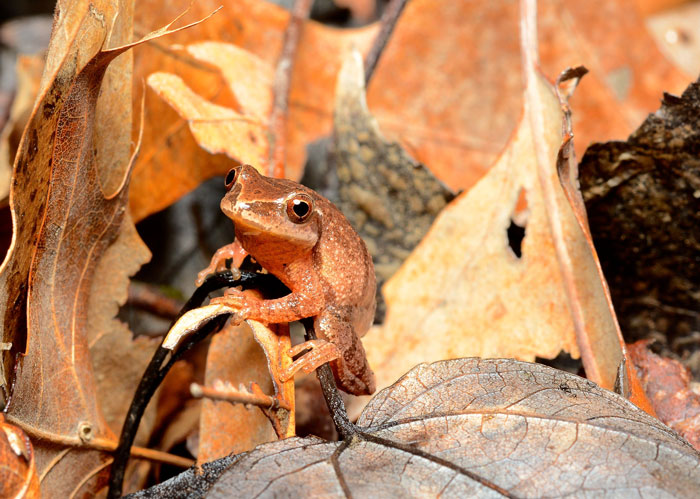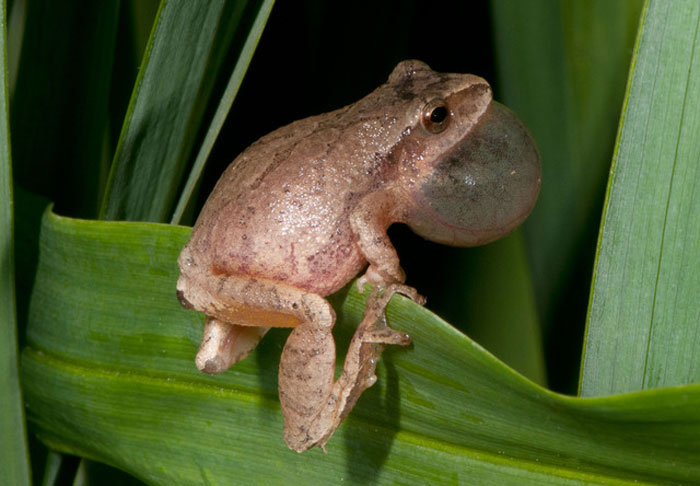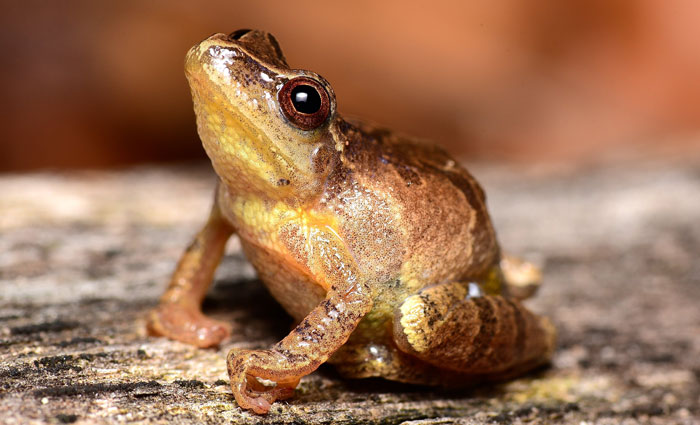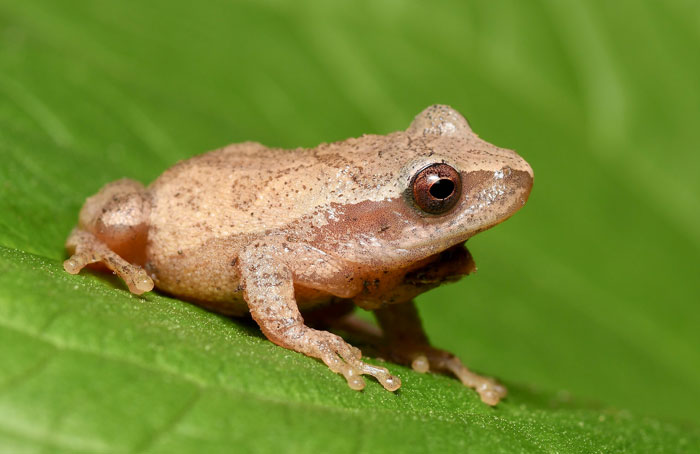Spring Peepers (Pseudacris crucifer) are a small chorus frog species found in the eastern parts of North America. They are known for their unique vocalization, which sounds like a high-pitched “peep”. This can often be heard at night during the spring mating season.
Despite their small size, Spring Peepers play an important role in the ecosystem. As predators of small insects, they help control insect populations. They are also prey for larger predators like birds and snakes.
Additionally, Spring Peepers are an indicator species, which means their presence indicates that spring is coming. Their scientific name comes from the Greek words “pseudes” meaning false, and “acris,” meaning locust.
In this comprehensive guide, we will explore the physical characteristics, habitat, behavior, and conservation status of Spring Peepers. We will learn other additional things as well. So, keep on reading!
Scientific Classification of Spring Peeper

| Specification | Title |
|---|---|
| Class | Amphibia |
| Order | Anura |
| Family | Hylidae |
| Genus | Pseudacris |
| Species | Pseudacris crucifer |
| Scientific Name | Pseudacris |
Physical Characteristics: The Fascinating Features That Make Spring Peepers Stand Out
With several pieces, we shall now discuss the morphological aspects of Spring peepers.

Physical Characteristics of Spring Peepers
Spring Peepers are characterized by their small size, distinct vocal sacs, and light brown coloration.
These Unique frogs are on the smaller side, with adult males typically measuring around 1 inch in length and females slightly larger at 1.5 inches. In terms of weight, Spring Peepers weigh no more than 5 grams.
Markings and Coloration of Spring Peepers
The coloration of Spring Peepers is primarily a light brown or grayish-brown, with dark cross-shaped markings running down their backs. Their scientific name “Pseudacris crucifer,” which means “cross-bearing false cricket.” This refers to the frog’s dorsum’s cross-like design.

These markings are more pronounced in some individuals than in others but generally make for a striking and recognizable appearance.
The Remarkable Skin Texture of Spring Peepers
The skin texture of Spring Peepers is generally smooth, with some individuals having small warts on their backs. Their smooth skin helps them move quickly through their wetland habitat, allowing them to evade predators and easily capture prey.
Different Species of Spring Peepers and Their Unique Traits

There are several Spring Peeper species found in North America. These are including
- The Northern Spring Peeper (Pseudacris crucifer):
It has cross-shaped markings on its back, and its skin color varies from brown to green. They are primarily nocturnal and feed on a variety of small invertebrates.
- Mountain Chorus Frog (Pseudacris brachyphona):
Also known as the Western Chorus Frog, is a small, highly vocal frog species that belongs to the treefrog family, Hylidae.
They are typically found in mountainous regions of western North America, ranging from British Columbia to California.
Adults usually grow to be around 4 cm long and have a distinct, dark stripe that runs from their snout to their groin.
Hibernation Behavior of Spring Peeper
One of the fascinating adaptations of Spring Peepers is their ability to survive harsh winter conditions through hibernation. During the winter, Spring Peepers burrow into leaf litter or soil to stay warm, reducing their metabolism to conserve energy.

This ability to hibernate allows them to survive in their wetland habitats through the cold winter months, where other frog species may not be able to survive.
Habitat of Spring Peepers
Knowing the habitat and behavior will make you understand Spring Peepers better. These discussions will feature an in-depth go-through of important things such as wetland ecosystems, geographical distribution, and elevation range.

Wetland Ecosystems
Spring peepers are commonly found in wetland ecosystems. Wetlands are important habitats for spring peepers because they provide the necessary breeding and foraging grounds for these amphibians.
Some examples of wetland ecosystems are given below:
- Forested Wetlands: These wetlands frequently feature a dense understory of shrubs and herbaceous plants. There are many different types of forested wetlands, such as floodplains, swamps, and bogs.
- Marshes: Wetlands known as marshes are distinguished by emergent herbaceous plants like cattails, reeds, and sedges. In low-lying places close to rivers, lakes, or the seaside, they are frequently discovered.
- Wet Meadows: Grasses, sedges, and other herbaceous plants are the dominant vegetation here. They are frequently found in floodplains and other regions with high water tables as well as inadequate drainage.
Preferred Environment
Spring peepers prefer to breed in vernal pools and other wetlands with dense vegetation, such as small ponds. These wetlands are fish-free and have an abundance of invertebrate prey for the tadpoles.

After breeding, spring peepers move to nearby upland habitats like forests or wet meadows to forage for insects and small invertebrates.
They prefer areas with moisture to maintain their skin moisture levels and high leaf litter ares are their preferred environment, as it provides food and shelter for their prey.
Geographical Distribution
- Spring peepers are native to eastern North America and have a wide distribution across the United States and Canada. They are found as far north as southern Ontario and Quebec and as far south as northern Florida.
- Northern spring peepers are found in the northeastern United States and southeastern Canada, ranging from southern Maine to central Georgia.
- Southern spring peepers are found in the southeastern United States, ranging from eastern Louisiana to northern Florida.
Elevation Range
The specific elevation range of spring peepers varies depending on the subspecies and the local environmental conditions. Spring peepers are generally more prevalent at lower elevations, usually less than 1,500 feet above sea level.
For instance, spring peepers have been observed in the Great Smoky Mountains National Park as high as 6300 feet in height.
Different Behavior by Spring Peepers During Breeding Season
To know how Spring Peepers behave in different ways, we have to know about different frog behavior parameters. These include activity patterns, locomotion, social structure, and communication.

Activity Patterns
- Spring peepers are nocturnal and create mating sounds to attract females during their breeding season.
- Females approach, calling males by listening to the male’s loud mating call and lay their eggs in the water.
- The eggs hatch into tadpoles and mature over several weeks.
- Spring peepers are primarily nocturnal and spend their days hiding in vegetation or burrows.
- At night, they forage on the ground for small insects, spiders, and other invertebrates.
- They have a long, sticky tongue that they use to capture prey.
- They can stay hidden during the day in vegetation or underground.
- They are also able to blend in with their surroundings by changing their skin color to match the color of the foliage.
Locomotion
- Spring peepers are usually arboreal. But during the breeding season, they move to ground-level breeding grounds.
- They have strong hind legs and sticky toe pads that allow them to grasp onto surfaces as they walk.
Social Structure
Male spring peepers create territories and use mating calls to attract females during the breeding season. Females choose males based on their mating calls and approach them to mate.
After mating, females lay eggs in the water, while males may move to new territories to find more partners. Spring peepers exhibit a polygynous mating pattern during the breeding season.
Communication
Male spring peepers use high-pitched mating calls to attract females and establish territory, which can be heard up to half a mile away. Females choose mates based on call quality and engage in courtship behavior before mating.

Predators and Defense Mechanism
Spring peepers face predators such as snakes, birds, and small mammals during the breeding season. They defend themselves through camouflage, jumping, and secreting toxic substances to increase their chances of survival.
Mating Habits and Breeding Behaviors:
Spring peepers are small, nocturnal frogs that inhabit forests, wetlands, and other humid areas. They have unique breeding behaviors that are fascinating to observe.

Here are some facts about their mating habits:
- Spring peepers usually breed in early spring, typically between March and May. It depends on the region and weather conditions.
- To attract females, male spring peepers produce a loud, high-pitched mating call that sounds like a series of high-pitched peeps or whistles.
- The fertilization type of spring peepers is external.
- After mating, the female will lay her eggs in shallow, temporary ponds or other bodies of water. Typically, they lay their eggs in clusters of 10-40, which are attached to submerged vegetation.
- The eggs hatch into tadpoles within a few days. The tadpoles will feed on algae and other small organisms in the water and undergo metamorphosis into juvenile frogs after about 2-3 months.
- Spring peepers do not show any significant parental care towards their offspring.
The breeding behaviors and life cycle of spring peepers are truly fascinating. And studying them can provide valuable insights into biology and frog ecology.
Spring Peepers’ Diet
The unique diet that spring peepers follow allows them to flourish in their native environments. They are intriguing creatures.

Primary Food Source
Spring peepers are insectivores, feeding primarily on insects and small invertebrates.
Male spring peepers may eat other male frogs during the breeding season to defend their territory and attract females. But this spring peeper behavior is uncommon and not a significant portion of their diet.
Foraging Strategies
Spring peepers forage primarily at night, when their prey is most active. They use their keen eyesight and hearing to locate potential prey, as well as their sense of smell.
Once they locate prey, they use their long, sticky tongues to capture it quickly.
Opportunistic Feeding Habit
Spring peepers adjust their feeding behavior based on the availability of prey in their habitat.
They occasionally eat other small vertebrates, but this is not a significant portion of their diet. They have been observed feeding on insects attracted to artificial light sources.
Conservation Status of Spring Peepers
As mentioned before, the Spring Peeper plays a critical role in maintaining ecological balance. However, despite their importance, spring peeper populations can be under threat due to various environmental factors.

Now, we will explore the current conservation status of spring peepers and the threats they face. At the same time, we will also explore their ongoing conservation efforts aimed at preserving their populations.
IUCN Red List Status
According to the International Union for Conservation of Nature (IUCN), the Spring Peeper is currently listed as a species of “Least Concern.”
This status indicates that while their population is relatively stable, the species still faces some threats to its survival. These threats include habitat loss, pollution, and climate change, among others.
Threats
Wetland habitats are essential for the survival of spring peepers as they require moist conditions for breeding, feeding, and shelter. However, due to human activities such as urbanization, deforestation, and agriculture, these frog habitats are rapidly disappearing.
As a result, spring peeper populations are declining, and their range is shrinking.
Pollution from agricultural runoff, industrial activities, and human waste is another significant threat to spring peepers. Exposure to pesticides, herbicides, and other pollutants can cause deformities, reproductive abnormalities, and death in spring peepers.
Climate change is another significant threat to spring peepers. Temperature rise can affect their breeding cycles, migration patterns, and feeding behaviors.
Furthermore, changes in rainfall patterns can lead to droughts or floods, negatively impacting spring peeper populations.
Overview of Conservation Efforts

Various frog conservation efforts are currently underway to protect spring peeper populations. These efforts include deep studies by research institutions, habitat preservation programs, legal protections, captive breeding programs, and habitat restoration.
- Research: Researchers are studying spring peepers to understand their biology, behavior, and ecology better. This information can help conservationists develop more effective spring peeper conservation strategies and management plans.
- Habitat Preservation Programs: Various conservation organizations are working to preserve and protect wetland habitats where spring peepers live. These programs include wetland restoration projects, land acquisition, and conservation easements.
- Legal Protections: Some countries, including the United States and Canada, have laws in place to protect spring peeper habitats. These laws provide legal protections and impose penalties for violations.
- Captive Breeding Programs: Some organizations are breeding spring peepers in captivity to ensure the survival of the species. These programs help to maintain genetic diversity and provide a backup population in case wild populations decline further.
- Habitat Restoration: Restoration efforts involve improving the quality of existing wetland habitats to make them more suitable for spring peepers. This includes removing invasive species, controlling pollution, and creating new breeding sites.
Importance of Continued Conservation Efforts:
Conservation efforts are critical for the survival of spring peepers and the wetland ecosystems they inhabit. These tiny amphibians play a crucial role in maintaining ecological balance, serving as both predator and prey in their food web.
Furthermore, they act as indicators. They make a sound that is believing as a beautiful day announcement. But scientifically, it is just indicating the temperature is rising, which means the incoming spring.
Thus, the decline of spring peeper populations can have far-reaching consequences for the entire ecosystem.
Interesting Facts About Spring Peepers

Your mind can be blown by a few interesting facts about Spring Peepers.
- Spring peepers are named after the sound they make, which sounds like a series of high-pitched peeps or whistles.
- Their vocalizations are so loud that they can be heard up to two miles away.
- They can change color from brown to green depending on their surroundings, allowing them to blend in and avoid predators.
Final Thoughts
Spring Peepers are found in eastern North America, known for their unique high-pitched “peep” vocalization.
Spring Peepers’ physical characteristics make them easily recognizable, which include distinct vocal sacs, light brown coloration with cross-shaped markings on their backs, and smooth skin texture.
These frogs are adapted to survive harsh winter conditions through hibernation, and they are commonly found in wetland ecosystems.
Their behavior usually includes nocturnal activity patterns and during mating seasons, unique mating sounds, which differ from their regular activity patterns.
Finally, understanding their physical characteristics, habitat, behavior, and conservation status is vital for their protection in the long run.

Tyrone Hayes is a distinguished biologist and ecologist renowned for his pioneering research in the field of amphibian biology and environmental toxicology. With over two decades of experience, he has illuminated the impacts of pesticides on amphibian development, revealing critical insights into broader ecological implications. Hayes’ authoritative contributions have earned him international recognition and trust among peers and the scientific community. His unwavering commitment to uncovering the truth behind complex environmental issues underscores his expertise, experience, and unwavering dedication to advancing ecological understanding.
